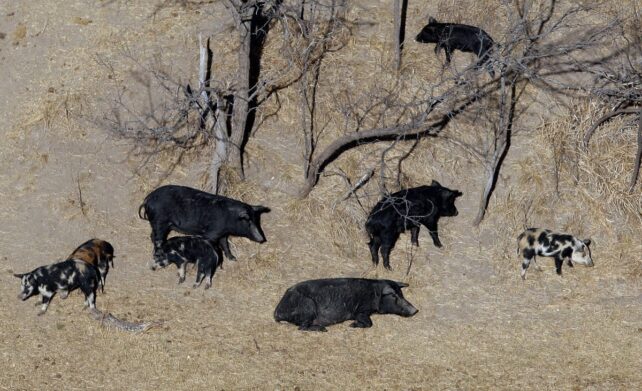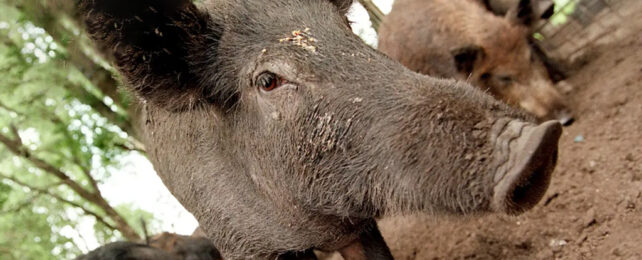A cross between a domestic pig and wild boar was bred in Canada decades ago. After escaping captivity, the "super pigs" spread throughout the country, wreaking havoc on native species and crops.
Now, they may be making their way into the US.
"They are the worst invasive large mammal on the planet. Period," Ryan Brook, a wildlife researcher and professor at the University of Saskatchewan who has studied the pigs for more than a decade, told Insider.
European wild boars were first brought to Canada in the 1980s to introduce a new and exotic pork product that could be uniquely marketed and served at upscale restaurants.
But as the boars started popping up on farms across Canada, they were crossbred with domestic pigs to make the swine bigger and more prolific. The new pigs could also grow thick furry coats, equipping them to survive the exceptionally cold Canadian winters, which can bring weeks of negative double-digit temperatures.
But there was a problem: The traits that made the "super pigs" desirable for the meat market also made them a nightmare once they escaped.
The breeders "basically turbocharged this wild boar with all the things that make it a really successful invasive species," Brook said, adding that wild boar alone would've been a problem, but the "super pigs" are much worse.
Then the boar market peaked, collapsing in 2001, and many of the pigs were simply let go. Brook said there are known occurrences of more than 300 pigs being released at one time. Others escaped, as the pigs were stronger and more adept at getting around fencing.
As a result, the number of feral pigs in Canada has exploded over the past couple of decades, leaving a trail of destruction in their wake.

An 'environmental train wreck'
The pigs, which can grow to well over 600 pounds, can thrive in varied landscapes, from forests to open prairies, and eat just about anything. Brook said that he and other researchers refer to the pigs as an "environmental train wreck."
They prey on native species like frogs and salamanders, and the nests of ground-nesting birds, like ducks and geese. They've even been found with white-tailed deer in their stomachs.
They also take a tremendous toll on the landscape, both natural and agricultural. They'll feast on most agricultural crops, though "corn is king," Brook said. And unlike a deer, which can graze on grass, mowing along without doing much damage, pigs use their noses to root directly into the dirt.
"When they push with those big, strong bodies, they just tear that ground up. They dig up plant roots, and insect larvae, and anything else they can eat in the ground," he said, adding that the "trail of destruction" makes it look as though "a small bomb went off."
The exposed ground in turn makes it easier for invasive plant species to move in, and the topsoil takes much longer to recover. Pigs can also contaminate water, which they roll around in to cool off and subsequently urinate and defecate in, and carry diseases that can be transferred to humans, including E. coli and hepatitis.
Feral pigs are already a major problem in the US. The USDA estimates feral pigs cause US$2.5 billion worth of damage to US agriculture each year. However, those pigs are primarily confined to the warmer climates of the south, mostly Texas and Florida.
But the super pigs from Canada could easily survive the frigid winters of states like Idaho, Montana, North Dakota, and Minnesota.
You can't 'BBQ your way out of a wild pig problem'
Brook said the risk of pigs moving to the US from Canada is "very real and increasing every single day."
He has documented the pigs within miles of the US-Canada border. One established population in Manitoba, which he referred to as a "wild pig factory," is located less than 40 miles from the border.
Wildlife officials in North and South Dakota have documented some occurrences of feral pigs that appear likely to have come from Canada, but so far none have been able to establish a permanent population in the northern US.
Many people have proposed hunting as a way to control feral pigs, a practice that is a common wildlife-management tool in the US. But, perhaps counterintuitively, hunting can make the problem worse.
The pigs, which can have two litters of six every year, reproduce too quickly for hunting to keep up, Brook said, adding that hunting pigs in the Canadian prairies hasn't done anything to slow their growth. In fact, the pigs will often adjust to hunters by becoming more elusive or spreading out into new places, ultimately helping their numbers grow.
"You simply can't BBQ your way out of a wild pig problem," he said. "That is just the reality."
Instead, he said Canada needs to take more concrete steps towards the removal of the wild pigs, and that officials in the US need to continue actively monitoring and removing pigs. Officials in Montana, for instance, launched the "Squeal on Pigs!" campaign to encourage residents to report feral swine.
Brook, who runs a Facebook page to educate the public on the feral pig problem, said that anyone who encounters a wild pig in North America should immediately notify local wildlife officials. He also encourages people to set up trail cameras, noting that people are often surprised to learn they have pigs in their area.
"They're a global problem," Brook said of feral pigs. "Everywhere they go they cause massive problems."
This article was originally published by Business Insider.
More from Business Insider: